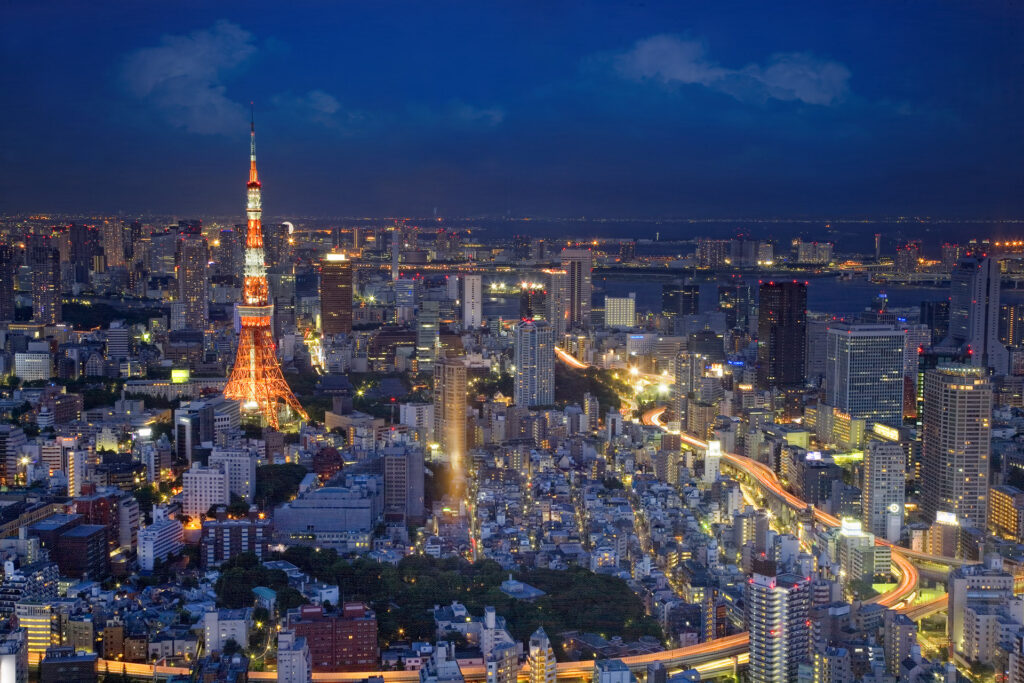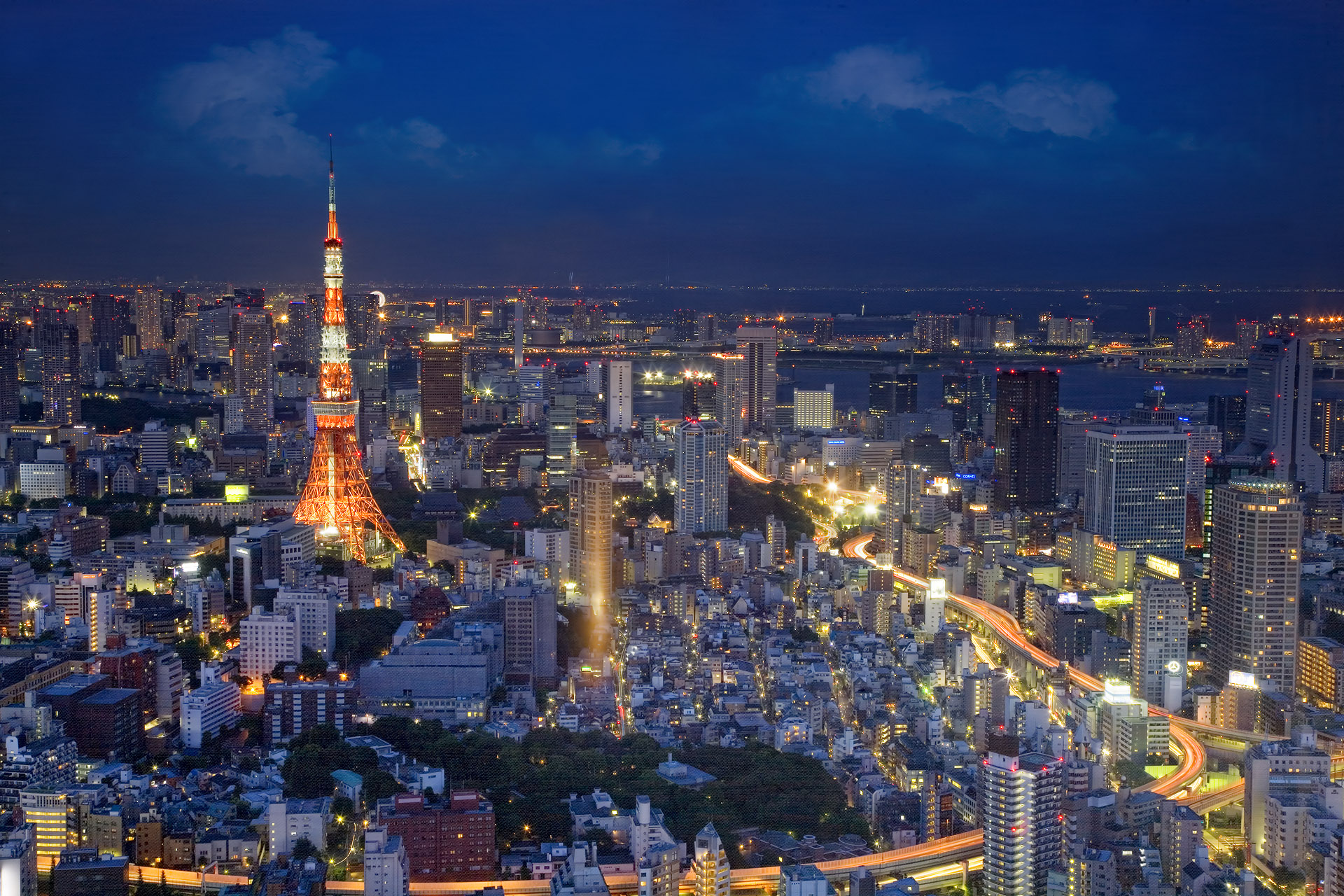
Japan (Japanese: 日本 Nihon or Nippon; formally 日本国) is an island nation in East Asia. Located in the Pacific Ocean, it lies to the east of the Sea of Japan, China, North Korea, South Korea and Russia, stretching from the Sea of Okhotsk in the north to the East China Sea and Taiwan in the south. The characters that make up Japan’s name mean “sun-origin”, which is why Japan is sometimes referred to as the “Land of the Rising Sun”.
Japan is an archipelago of 6,852 islands. The four largest islands are Honshū, Hokkaidō, Kyūshū and Shikoku, together accounting for ninety-seven percent of Japan’s land area. Japan has the world’s tenth-largest population, with over 127 million people. The Greater Tokyo Area, which includes the de facto capital city of Tokyo and several surrounding prefectures, is the largest metropolitan area in the world, with over 30 million residents.
Archaeological research indicates that people lived in Japan as early as the Upper Paleolithic period. The first written mention of Japan is in Chinese history texts from the 1st century AD. Influence from other nations followed by long periods of isolation has characterized Japan’s history. In the late 19th and early 20th centuries victory in the First Sino-Japanese War, the Russo-Japanese War, and World War I allowed Japan to expand its empire during a period of increasing militarism. The Second Sino-Japanese War of 1937 expanded into part of World War II, which came to an end in 1945 following the atomic bombings of Hiroshima and Nagasaki. Since adopting its revised constitution in 1947, Japan has maintained a unitary constitutional monarchy with an emperor and an elected parliament called the Diet.
A major economic power, Japan has the world’s third-largest economy by nominal GDP and fourth-largest economy by purchasing power parity. It is also the world’s fourth-largest exporter and fourth-largest importer. Although Japan has officially renounced its right to declare war, it maintains a modern military force in self-defense and peacekeeping roles. After Singapore, Japan has the lowest homicide rate (including attempted homicide) in the world. According to both UN and WHO estimates, Japan has the longest life expectancy of any country in the world. According to the UN, it has the third lowest infant mortality rate.
Japanese language
The Japanese language is spoken mainly in Japan, but also in some Japanese immigrant communities around the globe. It is an agglutinative language and the sound inventory of Japanese is relatively small but has a lexically distinct pitch-accent system. Early Japanese is known largely on the basis of its state in the 8th century, when the three major works of Old Japanese were compiled. The earliest attestation of the Japanese language is in a Chinese document from 252 A.D.
Religion
Upper estimates suggest that 84–96 percent of the Japanese population subscribe to Buddhism or Shinto, including a large number of followers of a syncretism of both religions. However, these estimates are based on people affiliated with a temple, rather than the number of true believers. Other studies have suggested that only 30 percent of the population identify themselves as belonging to a religion. Nevertheless the level of participation remains high, especially during festivals and occasions such as the first shrine visit of the New Year. Taoism and Confucianism from China have also influenced Japanese beliefs and customs.Fewer than one percent of Japanese are Christian. In addition, since the mid-19th century numerous new religious movements have emerged in Japan.
Politics
Japan is a constitutional monarchy where the power of the Emperor is very limited. As a ceremonial figurehead, he is defined by the constitution as “the symbol of the state and of the unity of the people”. Power is held chiefly by the Prime Minister of Japan and other elected members of the Diet, while sovereignty is vested in the Japanese people. Akihito is the current Emperor of Japan; Naruhito, Crown Prince of Japan, stands as next in line to the throne.
Japan’s legislative organ is the National Diet, a bicameral parliament. The Diet consists of a House of Representatives with 480 seats, elected by popular vote every four years or when dissolved, and a House of Councillors of 242 seats, whose popularly-elected members serve six-year terms. There is universal suffrage for adults over 20 years of age, with a secret ballot for all elected offices. In 2009, the social liberal Democratic Party of Japan took power after 54 years of the liberal conservative Liberal Democratic Party’s rule. The Prime Minister of Japan is the head of government and is appointed by the Emperor after being designated by the Diet from among its members. The Prime Minister is the head of the Cabinet and appoints and dismisses the Ministers of State. Naoto Kan was designated by the Diet to replace Yukio Hatoyama as the Prime Minister of Japan on June 2, 2010.Although the Prime Minister is formally appointed by the Emperor, the Constitution of Japan explicitly requires the Emperor to appoint whoever is designated by the Diet. Emperor Akihito formally appointed Kan as the country’s 94th Prime Minister on June 8.
Japanese culture
The culture of Japan has evolved greatly over the millennia, from the country’s prehistoric Jōmon period, to its contemporary hybrid culture, which combines influences from Asia, Europe, and North America. The inhabitants of Japan experienced a long period of relative isolation from the outside world during the Tokugawa shogunate, until the arrival of “The Black Ships” and the Meiji period.
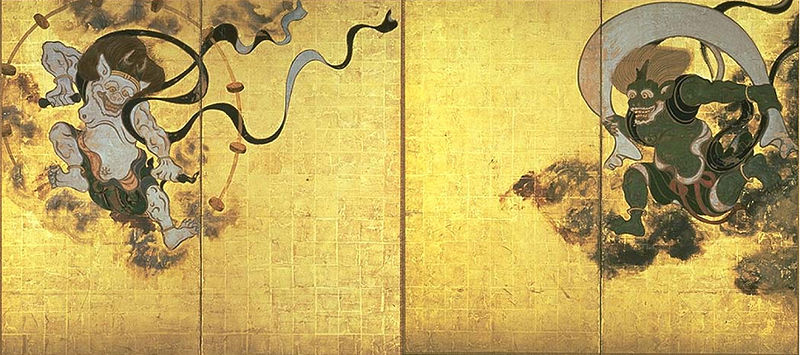
Painting
Painting has been an art in Japan for a very long time: the brush is a traditional writing tool, and the extension of that to its use as an artist’s tool was probably natural. Chinese papermaking was introduced to Japan around the 7th century by Damjing and several monks of Goguryeo, later washi was developed from it. Native Japanese painting techniques are still in use today, as well as techniques adopted from Continental Asia and from the West.
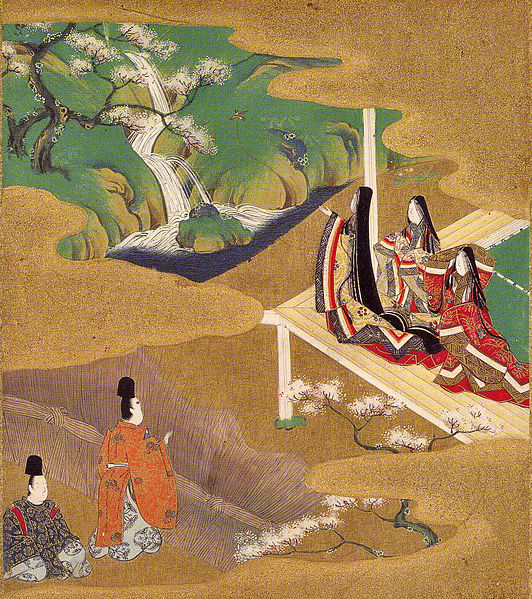
Calligraphy
The flowing, brush-drawn Japanese language lends itself to complicated calligraphy. Calligraphic art is often too esoteric for Western audiences and therefore general exposure is very limited. However in East Asian countries, the rendering of text itself is seen as a traditional art form as well as a means of conveying written information. The written work can consist of phrases, poems, stories, or even single characters. The style and format of the writing can mimic the subject matter, even to the point of texture and stroke speed. In some cases it can take over one hundred attempts to produce the desired effect of a single character but the process of creating the work is considered as much an art as the end product itself.
This calligraphy form is known as ‘shodō’ (書道) which literally means ‘the way of writing or calligraphy’ or more commonly known as ‘shūji’ (習字) ‘learning how to write characters’.
Commonly confused with Calligraphy is the art form known as ‘sumi-e’ (墨絵) literally means ‘ink painting’ which is the art of painting a scene or object.
Sculpture
Traditional Japanese sculptures mainly consisted of Buddhist images, such as Tathagata, Bodhisattva, and Myō-ō. The oldest sculpture in Japan is a wooden statue of Amitābha at the Zenkō-ji temple. In the Nara period, Buddhist statues were made by the national government to boost its prestige. These examples are seen in present-day Nara and Kyoto, most notably a colossal bronze statue of the Buddha Vairocana in the Tōdai-ji temple.
Wood has traditionally been used as the chief material in Japan, along with traditional Japanese architecture. Statues are often lacquered, gilded, or brightly painted, although there are little traces on the surfaces. Bronze and other metals are also used. Other materials, such as stone and pottery, have had extremely important roles in the plebeian beliefs.
Ukiyo-e
Ukiyo-e, literally “pictures of the floating world”, is a genre of woodblock prints that exemplifies the characteristics of pre-Meiji Japanese art. Because these prints could be mass-produced, they were available to a wide cross-section of the Japanese populace — those not wealthy enough to afford original paintings — during their heyday, from the 17th to 20th century.
Ikebana
Ikebana (生花?) is the Japanese art of flower arrangement. It has gained widespread international fame for its focus on harmony, color use, rhythm, and elegantly simple design. It is an art centered greatly on expressing the seasons, and is meant to act as a symbol to something greater than the flower itself.
Performing arts
The four traditional theatres from Japan are noh (or nō), kyōgen, kabuki, and bunraku. Noh had its origins in the union of the sarugaku, with music and dance made by Kanami and Zeami Motokiyo. Among the characteristic aspects of it are the masks, costumes, and the stylized gestures, sometimes accompanied by a fan that can represent other objects. The noh programs are presented in alternation with the ones of kyōgen, traditionally in number of five, but currently in groups of three.
The kyōgen, of humorous character, had older origin, in 8th century entertainment brought from China, developing itself in sarugaku. In kyōgen, masks are rarely used and even if the plays can be associated with the ones of noh, currently many are not.[2]
Kabuki appears in the beginning of the Edo period from the representations and dances of Izumo no Okuni in Kyoto.[3] Due to prostitution of actresses of kabuki, the participation of women in the plays was forbidden by the government in 1629, and the feminine characters had passed to be represented only by men (onnagata). Recent attempts to reintroduce actresses in kabuki had not been well accepted. Another characteristic of kabuki is the use of makeup for the actors in historical plays (kumadori).
Japanese puppet theater bunraku developed in the same period, that kabuki in a competition and contribution relation involving actors and authors. The origin of bunraku, however is older, lies back in the Heian period. In 1914, appeared the Takarazuka Revue a company solely composed by women who introduced the revue in Japan.
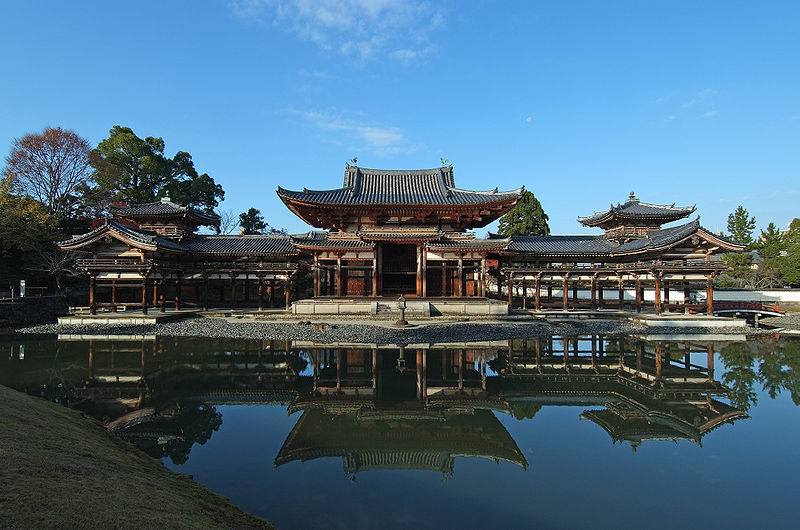
Architecture
Japanese architecture has as long of a history as any other aspect of Japanese culture. Originally heavily influenced by Chinese architecture, it also develops many differences and aspects which are indigenous to Japan. Examples of traditional architecture are seen at temples, Shinto shrines, and castles in Kyoto and Nara. Some of these buildings are constructed with traditional gardens, which are influenced from Zen ideas.
Some modern architects, such as Yoshio Taniguchi and Tadao Ando are known for their amalgamation of Japanese traditional and Western architectural influences.
Gardens
Garden architecture is as important as building architecture and very much influenced by the same historical and religious background. Although today, ink monochrome painting still is the art form, most closely associated with Zen Buddhism. A primary design principle of a garden is the creation of a landscape based on, or at least greatly influenced by, the three-dimensional monochrome ink (sumi) landscape painting, sumi-e or suibokuga.
In Japan, the garden has the status of artwork.
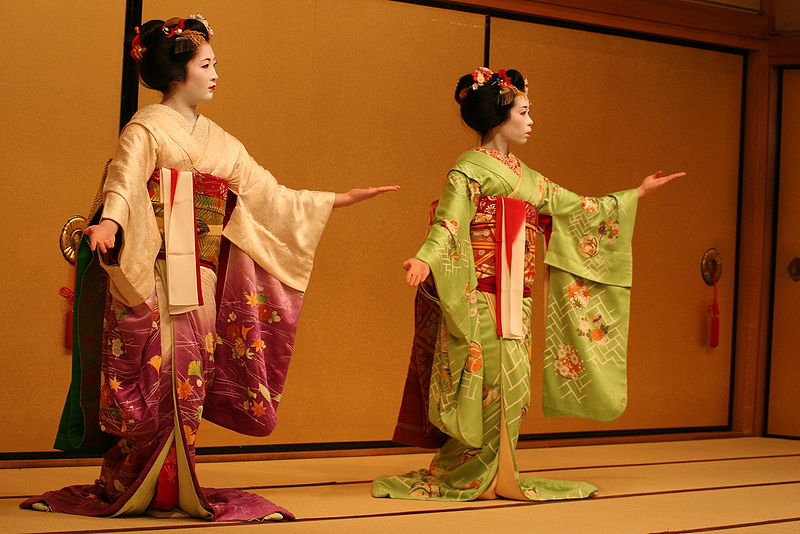
Traditional clothing
Traditional Japanese clothing distinguishes Japan from all other countries around the world. The Japanese word kimono means “something one wears” and they are the traditional garments of Japan. Originally, the word kimono was used for all types of clothing, but eventually, it came to refer specifically to the full-length garment also known as the naga-gi, meaning “long-wear”, that is still worn today on special occasions by women, men, and children. Kimono in this meaning plus all other items of traditional Japanese clothing is known collectively as wafuku which means “Japanese clothes” as opposed to yofuku (Western-style clothing). Kimonos come in a variety of colours, styles, and sizes. Men mainly wear darker or more muted colours, while women tend to wear brighter colors and pastels, and, especially for younger women, often with complicated abstract or floral patterns.
The kimono of a woman who is married (tomesode) differs from the kimono of a woman who is not married (furisode). The tomesode sets itself apart because the patterns do not go above the waistline. The furisode can be recognized by its extremely long sleeves spanning anywhere from 39 to 42 inches, it is also the most formal kimono an unwed woman wears. The furisode advertises that a woman is not only of age but also single.
The style of kimono also changes with the season, in spring kimonos are vibrantly colored with springtime flowers embroidered on them. In the fall, kimono colors are not as bright, with fall patterns. Flannel kimonos are ideal for winter, they are a heavier material to help keep you warm.
One of the more elegant kimonos is the uchikake, a long silk overgarment worn by the bride in a wedding ceremony. The uchikake is commonly embellished with birds or flowers using silver and gold thread.
Kimonos do not come in specific sizes as most western dresses do. The sizes are only approximate, and a special technique is used to fit the dress appropriately.
The obi is a very important part of the kimono. Obi is a decorative sash that is worn by Japanese men and women, although it can be worn with many different traditional outfits, it is most commonly worn with the kimono. Most women wear a very large elaborate obi, while men typically don a more thin and conservative obi.
Most Japanese men only wear the kimono at home or in a very laid back environment, however it is acceptable for a man to wear the kimono when he is entertaining guests in his home. For a more formal event a Japanese man might wear the haori and hakama, a half coat and divided skirt. The hakama is tied at the waist, over the kimono and ends near the ankle. Hakama were initially intended for men only, but today it is acceptable for women to wear them as well. Hakama can be worn with types of kimono, excluding the summer version, yukata. The lighter and simpler casual-wear version of kimono often worn in summer or at home is called yukata.
Formal kimonos are typically worn in several layers, with number of layers, visibility of layers, sleeve length, and choice of pattern dictated by social status, season, and the occasion for which the kimono is worn. Because of the mass availability, most Japanese people wear western style clothing in their everyday life, and kimonos are mostly worn for festivals, and special events. As a result, most young women in Japan are not able to put the kimono on themselves. Many older women offer classes to teach these young women how to don the traditional clothing.
Happi is another type of traditional clothing, but it is not famous worldwide like the kimono. A happi (or happy coat) is a straight sleeved coat that is typically imprinted with the family crest, and was a common coat for firefighters to wear.
Japan also has very distinct footwear.
Tabi, an ankle high sock, is often worn with the kimono. Tabi are designed to be worn with geta, a type of thonged footwear. Geta are sandals mounted on wooden blocks held to the foot by a piece of fabric that slides between the toes. Geta are worn both by men and women with the kimono or yukata.
Cuisine
Through a long culinary past, the Japanese have developed sophisticated and refined cuisine. In recent years, Japanese food has become fashionable and popular in the United States, Europe, and many other areas. Dishes such as sushi, tempura, and teriyaki are some of the foods that are commonly known. According to Japan’s Institute of Cetacean Research “Whaling and whale cuisine are part of Japanese culture”,and Japan is the world’s largest consumer of whale meat.[8] The Japanese diet consists principally of rice; fresh, lean seafood; and pickled or boiled vegetables. The healthy Japanese diet is often believed to be related to the longevity of Japanese people.

